Head collars for dogs such as the Halti and the Gentle Leader are designed to fit around the dog’s muzzle and limit his pulling. This article compares the Halti vs. Gentle Leader to help you choose the best tool for your dog.
Both the Halti and the Gentle Leader make it easier for the handler to manage the dog on walks by controlling the dog’s head.
Simply, the dog is generally not able to pull as hard. These tools also prevent dogs from making choking and gagging sounds!
Haltis and Gentle Leaders are often referred to as “head collars.”
There are other brands of head collars available, but these seem to be the most popular in the United States.
I’ll go over the pros and cons of both.
Halti head collar
There are two things about the Halti head collar that make it slightly more effective than the Gentle Leader:
1. The Halti has an extra safety strap from the nose to the neck
This keeps the other strap from pulling to the side or up into the dog’s eyes, which happened all the time with my Ace and his Gentle Leader.
2. The Halti also clips to the dog’s regular collar for safety
Newer Haltis feature the additional strap/loop that connects the Halti and the regular dog collar. This is a good safety for really strong dogs or dogs that manage to wiggle their nose out.
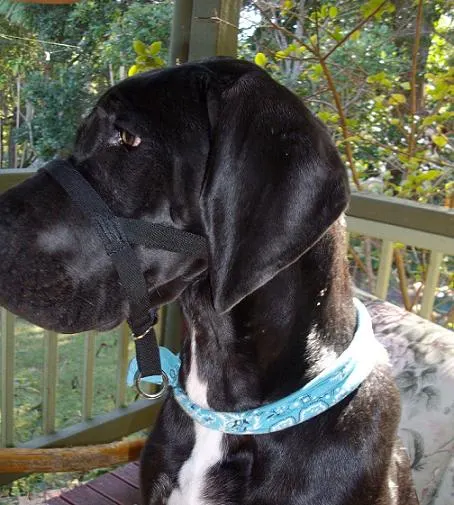
With this strap, you don’t loose control of your dog if the Halti comes undone for whatever reason. Your leash will still be connected to the regular collar.
Pros of the Halti head collar
- Thick neoprene padded noseband adds comfort
- Safety loop for extra safe walks
- Looser fit than the Gentle Leader
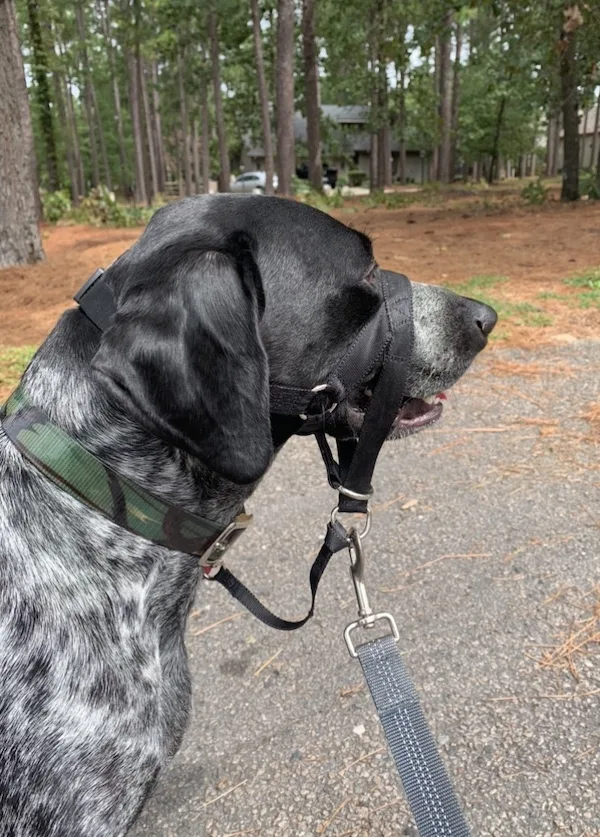
Cons of the Halti
- Harder to get dogs used to than the Gentle Leader
- Pricing depends on sizing
The Halti is generally available in a vast variety of sizes ranging from size 0 to size 5, which makes it a great option for tiny dogs as well as giant ones.
However, the price of the Halti depends on the size, and ranges from $6 for the smallest one to $20 for the largest.
What is a Gentle Leader head collar?
Unlike certain newer models of the Halti, the Gentle Leader only attaches to the leash, but not to the leash AND the dog’s regular collar.
Ace never got his Gentle Leader off, but my dog Remy is able to paw it off. It would be nice to have that added attachment to the collar.
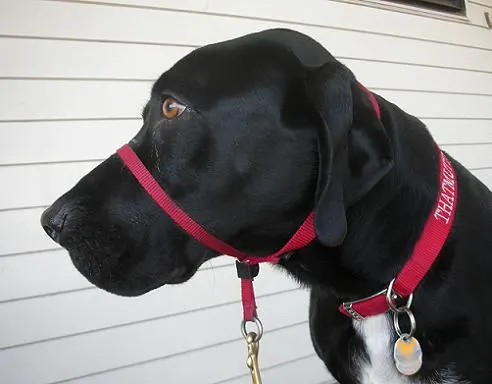
Pros of the Gentle Leader
- Easier to put on than a Halti
Cons of the Gentle Leader
- Either no or very thinly padded noseband that can cause chafing
- Feels more flimsy because it’s less complex than the Halti
- No safety strap
Gentle leaders are available in 5 different sizes, which make them great for tiny dogs under 5 lb all the way up to giant pups of 130+ lb.
Unlike with the Halti, the price is always the same around $16 and does not depend on the different sizes.
*Enjoying this article? Get realistic dog training tips emailed once a week. Click Here
Halti vs. Gentle Leader – the main differences
Besides the slight differences I mentioned, the Gentle Leader and the Halti are basically the same. I refer to both as head collars, and they serve the same purpose.
They are tools to teach a dog not to pull, and they make it a lot easier to walk and control a dog if he does pull. They’re also a good fit for reactive dogs who lunge and they make it easy to walk several dogs together.
Head collars fit over a dog’s muzzle like a halter on a horse and snap behind the ears.
Most dog owners can benefit from using a head collar with their dogs. People find them more humane than choke or pinch collars because they don’t tighten around a dog’s neck. If you’re not sure, you may be interested in my post on reasons not to buy a Halti.
I use all types of collars with my dogs, but the head collars work well when I bike with my dog because he can’t pull me.
Even with a pinch collar, he can easily pull if he tries. I also have him on a head collar when I take him to certain places where I have a harder time controlling him such as stores that allow dogs or public dog events.
General downsides of head collars
The main problem with head collars is that untrained dogs will go right back to pulling when they’re on a normal collar. Of course, this is also true with other training collars such as choke collars.
Some dogs take longer to accept a head collar than others and will put up a real fight when you’re trying to put it on them.
That’s why patience is key when you’re getting them used to it. Use smelly, high-value treats when you first introduce the collar!
Remember that it’s a brand-new sensation for them because they typically don’t wear anything around their nose. Yummy treats will make them more willing to work with you.
And I mean YUMMY, not boring milk bone treats. Try something like cut up hot dog, cheese, anything fishy or with green tripe!
Head collars usually don’t fit well on dogs with shorter muzzles
Be aware of the fact that head collars are not a good fit for brachycephalic dogs. Those are dogs with shortened nasal passages i.e. muzzles like boxers, pugs, bulldogs, etc.
Many people have asked me if my dog can still open his mouth with a head collar on. Yes, he can. These are not muzzles, although many people mistake them for muzzles. He can bite, pant, drink, eat, drool, you name it.
If you don’t feel like repeatedly explaining what your dog is wearing around his head and that NO, it’s not a muzzle, a head collar may not be the right choice for you.
Other training collar options
Instead, you may be interested in using some of the following options when training your dog to stop pulling and/or lunging on the leash.
Tip: Make sure that you understand how to properly use each of these collars. You can ask a professional dog trainer, watch a good, instructional YouTube video, or ask me in the comment section below this article.
Martingale Collar or Limited-Slip Collar
A martingale collar consists of two loops. The larger one goes over the dog’s neck, and the smaller one is what the leash gets attached to. They fit loosely around the dog’s neck and tighten slightly when the dog pulls.
They’re great for escape artists because dogs can’t get out of them. However, they’re only a good option for moderate pullers.
Slip Collar or Choke Collar
Slip collars slip over the dog’s head, just like the name suggests.
They’re also known as choke collars because you can use them to give a quick cue where the collar tightens and then releases on the dog’s neck.
They come in a variety of materials such as rope, nylon, metal, and leather.
Just like the martingale collars, they’re fairly escape proof.
Prong Collar or Pinch Collar
The prong collar is designed similarly to the martingale collar as it consists of two loops. The main difference is that the prong collar’s loops are made of metal, and the large loop consists of flat, metal prongs.
The leash attaches to the smaller loop. When it’s pulled for correction purposes, the prongs tighten around the dog’s neck and then releases when there is no pressure.
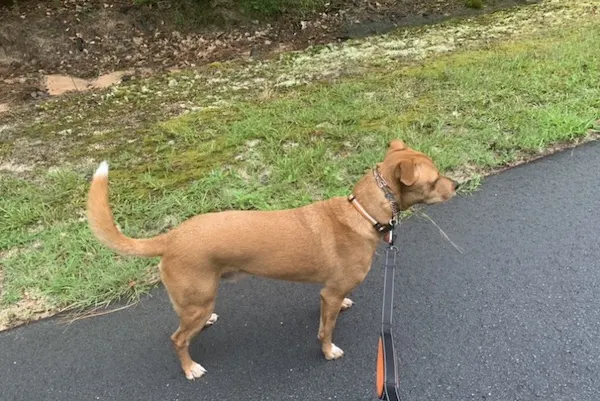
E-Collar
E-collars are wireless electric training collars with a wide range of training intensity. They consist of a collar with a wireless transmitter and a remote that controls the collar.
They’re used to pair a cue with the appropriate response. For example, you could teach your dog to come to you when he hears the tone or vibration on the collar.
Or, you can use a vibration to cue your dog into heel position, similar to how you would give a cue with a slip collar or martingale collar.
E-collars are mostly used to teach a dog to come back to the handler when off leash. They can also be used to correct unwanted behaviors such as barking or digging.
What do you think of the Halti vs Gentle Leader?
Let us know in the comments!
*Enjoying this article? Get realistic dog training tips emailed once a week. Click Here
Lindsay Stordahl is the founder of That Mutt. She writes about dog training, dog exercise and feeding a healthy raw diet.
Barbara Rivers contributed to this article. She writes regularly for That Mutt and is a blogger, raw feeder and dog walker. She maintains the blog K9s Over Coffee.
Related articles:
- How to stop my dog from pulling
- No pull harness vs. Gentle Leader
- Why I use a head collar for dogs – Halti or Gentle Leader

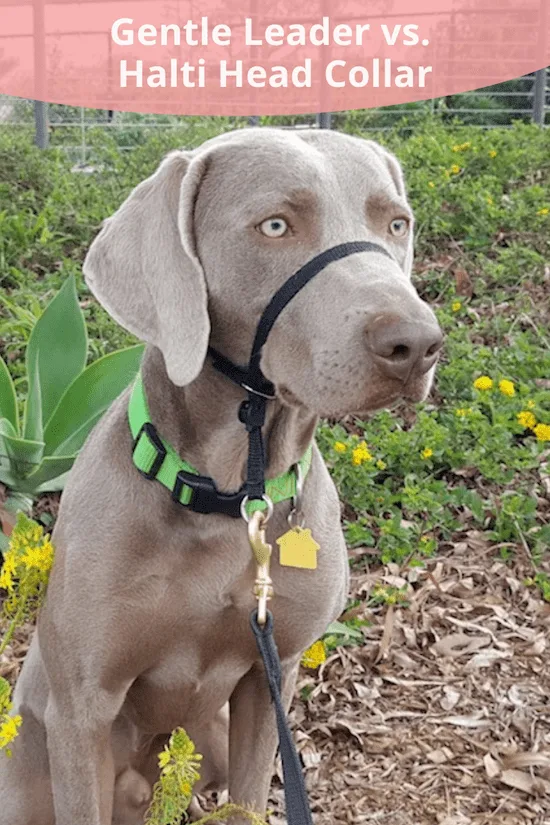
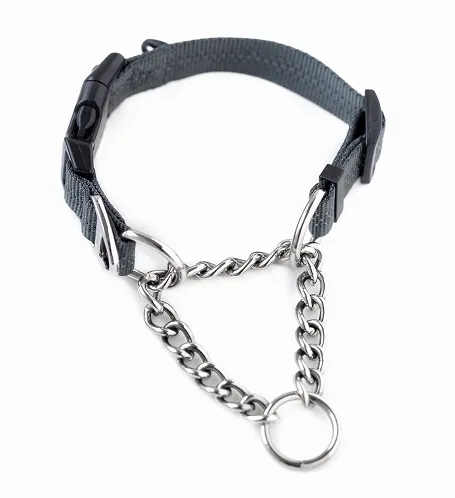

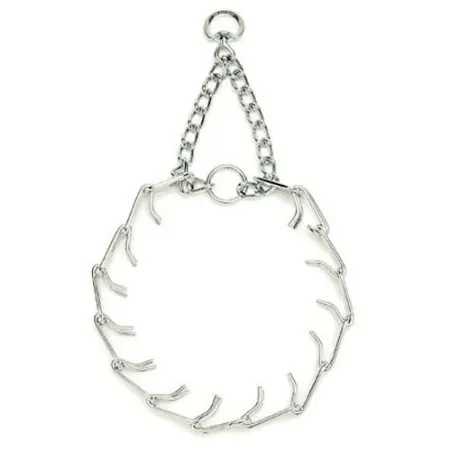
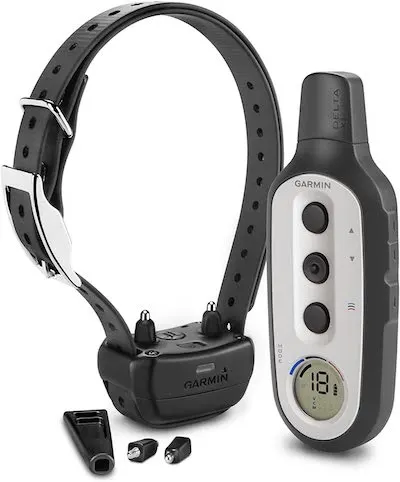
sally buuck
Saturday 19th of October 2024
our doodle continues to back out of leashes when getting out of the car. can't seem to find harness or head restraint that works. Woodrow is a large sheep doodle at 106lbs.
Ska Eurasier
Friday 25th of October 2024
@sally buuck, your dog is a "mutt" not a "doodle". No such thing as a doodle in dog breeds.
Nancy
Thursday 14th of January 2016
I have used the gentle leader with my 98 pound lab and he has always hated it. I didn't like the fact I had to make it so tight to work and it always slipped to the side which made him pull more and he is extremely strong . He doesn't seem to be able to pant well with it one. I also have a new pup and he is a 75 pound 7 month old lab that is bull headed and stubborn and much stronger than his father and in no way could I walk him on a leash after he was 5 months old. I took him to obedience class and they gave me a halti which he fought for maybe 10 minutes. I am so in love with it. it works so much better than the GL and he can pant and drink and take a treat with it on. We work on our homework for the stubbornness and I love the extra safety clip to his collar so I can drop the halti down and practice with the regular collar. I personally cant tell much difference in the thickness or quality and will get one of these for the big dog so I can walk him in comfort.
Lindsay Stordahl
Thursday 14th of January 2016
I think you make some great points. Those are some of the reasons I like the Halti a little better as well, mainly for really strong pullers!
AuntSue
Tuesday 2nd of September 2014
I started using a head collar when my daughter's pointer mix jerked me the wrong way and I had to have physical therapy for my shoulder. After a few months, she learned to walk nicely by our side. When I adopted a chi/Italian greyhound mix, I could not believe how he could pull. With a head collar on, he learned to behave. It took him about 6 months to learn how to heel, or walk gently with a martingal collar and a loose leash. My new rescue is a rat terrier. She is 7 years old and had never been walked because she pulled. Wow! What a difference. She does not like it, but she comes willingly to put it on so she can go for a walk. She seems much more secure when she is heeled and under my control. She is still a reactive dog (other dogs, cats, bicycles, motorcycles, etc) But quickly calms down. Sometimes she actually just walks by. She has been on a halti for a year, I hope to eventually not need to use it, but she is a terrier. We will see.
Lindsay Stordahl
Wednesday 3rd of September 2014
Oh I'm so glad to hear these tools have made a difference for all your dogs. That's good to hear! My goal is always to wean the dog off of them as well, but it just depends on the dog.
Leonie
Sunday 4th of May 2014
I have had both a Halti and Gentle Leaders. I have two foxies and the Jack Russell is powerful and I am fairly disabled. I cannot walk my dogs at all without the nose control. I lost one Gentle Leader and had to use a Halti. My Jack Russell chewed thru it immediately because there is no way you can adjust the nose size. Next, the collar part slipped somehow and was totally loose and the nose part, I sewed it back making it smaller he still could chew it and it still fell off. I have nearly lost him every time I have used it in built up city area. Alternatively the Gentle Leader is simple and easy to fit and put on and is literally what it says it is, the webbing is stronger so the dog is safe and of course cannot chew it as I can adjust it to fit the nose perfectly, no way can he get it into his mouth because it sits further back on the head past his jaw . Doesn't need a safety strap. One tiny dog, who can still pull and get out of things, and one powerful Jack Russell, we now have peaceful pleasant walks with no pulling because they simply can't and I feel confident that my dogs are safe to walk around traffic and other dogs. Without the Gentle Leader which is very well made and simple, strong and easy to put on we would not be able to go for walks at all. The Halti, still expensive, is now totally ruined after 3 walks! Thank god for the safety lead as it is very much needed. The webbing is not strong enough and because the nose piece cannot be adjusted to fit the nose a clever dog can get his mouth in and chew it off! There is a warning that that can happen, how to prevent it, I am walking my dogs not checking the Halti to see if he is having fun eating it. I would say the Halti is only suitable for placid breeds who have no inclination to play with the thing. The Jack Russell is not a chewer in general he did it because he could!
lablovr09
Sunday 6th of October 2013
My 90lb lab is 18 months old and has always pulled on his walks. I was using a harness where the leash attached on the front and it helped a little but he would still practically pull my arm off if he saw a dog friend or was startled by another dog. Well, let me tell you that the Halti lead is amazing!! He is a completely different dog and now we both enjoy the walk. It did take some getting use to on his part and at first he tried to remove it with his paws but he is much more comfortable with it now. I would strongly encourage anyone who has a puller to invest in the Halti and give it a try!!!
Lindsay Stordahl
Monday 7th of October 2013
So glad it's helped you and your dog.